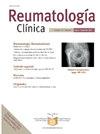Rotator cuff tendinopathy is associated with increased activity score in rheumatoid arthritis
IF 1.3
Q4 RHEUMATOLOGY
引用次数: 0
Abstract
Introduction and objective
Rheumatoid arthritis (RA) is often accompanied by musculoskeletal (MS) symptoms, which can hinder the diagnosis of concurrent conditions like rotator cuff tendinopathy (RCT), the most common cause of shoulder pain. Undiagnosed RCT in patients with RA may be associated with higher disease activity scores. This study aimed to assess the difference in these scores between RA patients with and without RCT, considering ultrasound pathological findings.
Methods
We conducted a cross-sectional, observational, comparative study in patients with shoulder pain who met the 2010 ACR-EULAR classification criteria for RA between January 2022 and January 2023. The measurements of Disease Activity Score based on 28 joints using C-Reactive Protein (DAS28-CRP), Erythrocyte Sedimentation Rate (DAS28-ESR), and the Clinical Disease Activity Index (CDAI) were used to evaluate RA activity, while functional capacity was assessed using the Health Assessment Questionnaire Disability Index (HAQ-DI). The Disabilities of the Arm, Shoulder, and Hand questionnaire (DASHe) and shoulder ultrasound examination was performed to detect the presence or absence of RCT.
Results
Patients with RCT had greater mean scores on DAS28-CRP (5.23, 1.28 vs. 3.08, p < 0.001), and DAS 28-ESR (5.43, SD = 1.28 vs. 3.66, p < 0.001). VAS median scores were higher in the RCT group (70.00 vs. 2.00, p < 0.001). By ultrasound 12 patients (21%) had acromioclavicular synovitis. Glenohumeral and acromioclavicular arthrosis was found in both groups. No patients had arthritis in the glenohumeral joint.
Conclusion
RA patients with RCT have higher composite index and disease activity scores than those without RCT. An intentional RCT screening should be recommended for those with shoulder pain and elevated disease activity.
类风湿性关节炎患者肩袖肌腱病变与活动评分增高相关
简介和目的类风湿性关节炎(RA)通常伴有肌肉骨骼(MS)症状,这可能会阻碍并发疾病的诊断,如肩袖肌腱病变(RCT),这是最常见的肩部疼痛原因。RA患者中未确诊的RCT可能与较高的疾病活动度评分相关。本研究旨在考虑超声病理结果,评估有和没有RCT的RA患者之间这些评分的差异。方法:我们对2022年1月至2023年1月期间符合2010年ACR-EULAR分类标准的肩痛患者进行了一项横断面、观察性、比较研究。采用c -反应蛋白(DAS28-CRP)、红细胞沉降率(DAS28-ESR)和临床疾病活动性指数(CDAI)对28个关节进行疾病活动性评分,评估RA活动性,采用健康评估问卷残疾指数(HAQ-DI)评估功能能力。通过手臂、肩膀和手的残疾问卷(DASHe)和肩部超声检查来检测是否存在RCT。结果RCT组患者在DAS28-CRP(5.23分,1.28比3.08分,p < 0.001)和DAS 28-ESR(5.43分,SD = 1.28比3.66,p < 0.001)上的平均得分更高。RCT组VAS中位评分较高(70.00 vs. 2.00, p < 0.001)。超声检查显示肩锁滑膜炎12例(21%)。两组患者均有肩关节和肩锁关节病变。没有患者有肩关节关节炎。结论RCT组ra患者的综合指数和疾病活动性评分均高于无RCT组。对于肩部疼痛和疾病活动度升高的患者,建议进行随机对照试验筛查。
本文章由计算机程序翻译,如有差异,请以英文原文为准。
求助全文
约1分钟内获得全文
求助全文
来源期刊

Reumatologia Clinica
RHEUMATOLOGY-
CiteScore
2.40
自引率
6.70%
发文量
105
审稿时长
54 days
期刊介绍:
Una gran revista para cubrir eficazmente las necesidades de conocimientos en una patología de etiología, expresividad clínica y tratamiento tan amplios. Además es La Publicación Oficial de la Sociedad Española de Reumatología y del Colegio Mexicano de Reumatología y está incluida en los más prestigiosos índices de referencia en medicina.
 求助内容:
求助内容: 应助结果提醒方式:
应助结果提醒方式:


